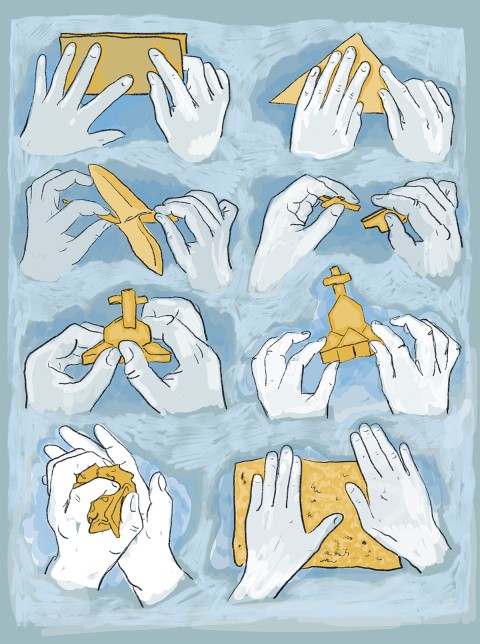A growing landscape of religious trauma
The conversation around abuse in religious contexts is intense, varied, and getting bigger.

These days, it seems like trauma talk is everywhere you turn. Looking back, signs of an approaching wave were there.
Published with relatively little fanfare in 2014, Dutch-born psychiatrist Bessel van der Kolk’s The Body Keeps the Score: Brain, Mind, and Body in the Healing of Trauma became a runaway bestseller, somewhat to the bemusement of its scholarly author. Then, a few years ago, a Vox writer noted that one search engine listed 5,500 podcasts with the word trauma in the title.
So perhaps it should come as no surprise that public conversation about religious trauma, specifically, is also on the rise. ChurchToo, a 2017 movement inaugurated with a Twitter hashtag, exposing sexual abuse in church settings, more recently is taking what may be the next logical step: widening the definition of trauma to include other church dynamics like “high-control religion” and purity culture.
Although in popular parlance the term trauma is often misappropriated to mean anything unpleasant or cringy, the American Psychological Association defines it as an emotional response to a terrible event, noting that shock and denial are typical.
“Trauma is anything that is too much too fast too soon, that overwhelms our ability to cope and come back to the place of safety,” said Nashville-based psychotherapist Laura Anderson, author of When Religion Hurts You: Healing from Religious Trauma and the Impact of High-Control Religion (see review in the November 2023 issue).
And because trauma is subjective and experienced through the body, “there doesn’t actually have to be a dangerous threat. It could be a remembered threat or a perceived threat,” Anderson added.
If there is a godmother of studying “religious trauma syndrome,” it’s Marlene Winell, a psychologist who is credited with coining the term in 2011. Author of Leaving the Fold: A Guide for Former Fundamentalists and Others Leaving Their Religion, Winell is also the founder of Journey Free, an organization dedicated to helping people move forward as they exit what they experienced as harmful religious environments.
Trauma in religious spaces is not limited to physical and sexual abuse, Winell said. Religious trauma can also include social, mental, and emotional abuse. Particularly in the more fundamentalist denominations of many faiths, she said, the assumption is that people should be afraid of what will happen to them after death.
“Teaching your child to be afraid that they are going to hell is emotional abuse to me,” she said.
And though many of the popular religious trauma narratives are focused on fundamentalist and conservative churches, accounts of traumatic experiences aren’t just emerging from evangelical circles, Winell said. She’s heard them from abuse survivors in mainline churches as well.
Sarah McCammon, national political correspondent for NPR, has come to believe that religious trauma is a special kind of trauma. In her book The Exvangelicals: Loving, Living, and Leaving the White Evangelical Church, McCammon explores how physical discipline—inflicted by adults as part of religious teaching—can fall into the trauma category, “because it says something essential about you as a spiritual being.”
So does the fear associated with particular religious teachings.
“I interviewed my own brother, and he talked about having almost textbook trauma symptoms when we were told that my grandfather—who came out late in life as gay—was going to hell,” McCammon said.
The effects of religious trauma can manifest in numerous ways. Anderson said high-control religion can trigger disorders like depression, anxiety, obsessive-compulsive disorder, gastrointestinal issues, and social phobias.
Jana Spangler, a wellness coach, Mormon, and self-described “nontraditional believer,” said her clients—whether they leave or stay in a high-control faith group—often have a complex nexus of symptoms: sexual shame, perfectionism, an underdeveloped sense of self, and “a relationship with the truth that doesn’t allow for an adult sense of privacy.”
“They feel like full disclosure of everything is required at all times,” she said, adding that she thinks the Church of Jesus Christ of Latter-day Saints has a lot of generational trauma.
“We tend to be very defensive. We really have a hard time being challenged. We can’t admit fault.” And that focus on self-reliance is itself, she said, a trauma response.
According to Spangler, advances in neuroscience suggest that the complex post-traumatic stress disorder some trauma survivors experience “is death by 1,000 cuts.” One study found that PTSD can trigger a different part of the brain than the one accessed in remembering something sad. The result is that past events can feel like they are happening in the present.
In high-control religious spaces, the increasing result of this trauma is that people leave. Especially younger women. As New York Times columnist Jessica Grose has suggested, many young women leave the church because they are rebelling against conservative religious beliefs about gender, reproductive rights, and sexuality. But others appear to be escaping from an experience they describe as traumatic.
But why now? It’s not that church-based trauma is new in and of itself. Survivors of church-based sexual abuse, assault, and authoritarian congregational culture have long told their stories and called for systematic reform. However, social media has enabled wider public attention to these revelations in the digital age.
And a number of women say Donald Trump’s political rise provided a disturbing inflection point. Watching swaths of the country rally around a man who was, arguably, “the opposite” of Jesus launched a mass exodus out of high-control religions, said Anderson.
Tia Levings, author of A Well-Trained Wife: My Escape from Christian Patriarchy, remembers how dissonant that moment felt to her, and to others. She told the CENTURY she could recall a time when the big political scandal was that then vice presidential candidate Dan Quayle couldn’t spell “potato.”
“Now we have Donald Trump, who grabbed women by their body parts, made fun of people in office, incited violence, and displayed every sign of being a narcissistic abuser,” Levings said.
Marie Griffith, a humanities professor at Washington University in St. Louis, said that several of the 80 sexual abuse survivors she’s interviewed have described Trump’s election, and their own growing understanding of him as a man who sexually abuses women, as “a moment of their own awakening.”
Fortunately, she added, these women have been able to connect to each other online in ways that were unthinkable in the past.
“Social media—and I don’t say this to be demeaning—is scripting a new narrative for people,” said Griffith. “They start to understand and put words to their experience.”
While leaving a traumatic environment is often the first step to healing, and people who do so today have more access to support than ever before, that doesn’t mean it’s an easy decision.
Daryl Van Tongeren, a psychology professor at Hope College and author of Done: How to Flourish After Leaving Religion, said leaving a religious community, especially a high-control community, can mean risking relationships or careers. That’s what happened to Levings. After she was excommunicated—in part for blog posts about homeschooling and the significance of the Virgin Mary—she says she was shunned by her former church community.
“Women I’d once chatted with after church refused to even look at me in the grocery store or at Cub Scouts. The level of rejection extends to children, who don’t understand theological disagreements between adults,” she said.
Where there’s been religious trauma, Van Tongeren said, the dissonance between a group’s teachings and one’s own experience can become too great. Leaving becomes the only option.
“There’s just too great of a discrepancy between what these folks are saying—what leaders are saying the world should be like or should happen—and their own internal experience of how they encounter the world,” he said.
Given the data and the anecdotal experiences of religious trauma survivors, it might be tempting to assume there is something fundamentally wrong with religion. But the picture is more complicated than that, said Harold G. Koenig, a professor of psychiatry and behavioral science at the Duke University Hospital of Medicine.
Koenig has been studying the effects of religion and spirituality on health for decades. And while unhealthy people can use religion to manipulate others, he said, in general, “religious involvement is related to better coping with stress, lower levels of depression, less anxiety, lower levels of substance abuse, and greater social support.”
Koenig and his team have developed a type of “religiously integrated” cognitive behavioral therapy for depression and anxiety that is heavily dependent on the original scriptures of Christianity, Judaism, Islam, Buddhism, and Hinduism.
“We ran it through a randomized control trial, and it showed that it significantly reduced depressive symptoms,” he said.
Ultimately, Koenig thinks survivors of religious trauma would benefit from finding a healthy faith community. Which is exactly the kind of church Michael Walrond, senior pastor of First Corinthian Baptist Church in Harlem, is trying to create.
According to Walrond, as Christianity became institutionalized in the fourth century, it began to stray from the teachings of a “craftsman who was on the lowest rung of the social order of his day.” So, if the church wants to address religious trauma, it needs to go old-school—as in pre-Constantinian old-school.
“The first thing we have to begin to do is the hard work of reimagining what Christianity is,” he said.
As part of his mission to reestablish the church as a place of healing and restoration, Walrond opened the HOPE Center, a free mental health clinic, at First Corinthian. The center, which is open to the wider community, is staffed by licensed therapists, psychologists, and social workers.
Walrond told the CENTURY that in Black communities, especially among the descendants of people who were enslaved, there’s a tendency to normalize trauma. That’s not OK, said the pastor.
“For me, it was always about looking at the needs of the community,” he said. “There was no way I can serve the community in Central Harlem—where there are so many tentacles of poverty—and not talk about mental health and wellness.”
For Levings, helping people heal from religious trauma can sometimes be as simple as an acknowledgment. It’s powerful, she said, when someone says, “I can’t believe that happened to you, and I’m not going to be affiliated with anybody who does that to someone.”
Ultimately, experts suggest that the behaviors associated with trauma may have more to do with the nature of human institutions and human beings themselves than about something peculiar to religion.
“Sometimes churches are not safe,” said Koenig, “because they contain people.”
Griffith concurred, saying, “Once you start thinking about a term like high-control, anything can fit into that category.” The term could be equally applied to law firms, corporations, or universities.
Yet, McCammon said she’s glad that a term like religious trauma exists to reference the specific harm she and others have experienced.
“Religion can obviously be a beautiful, positive influence for a lot of people, providing support and direction,” she said. But it cannot be taken for granted that religion is a universally positive force. “Look around the world. There is so much violence that has occurred and still occurs around religion. I’m not here to bash it, but I think it’s important to be honest about that part of it.”
Given the transformational effect social media has had on public communication, along with skepticism about institutions in an increasingly secular culture, the debate over what constitutes religious trauma will likely continue. It may even accelerate.
However one defines religious trauma, the underlying question remains: Is it possible to recover from these negative experiences?
Winell, who has decades of experience working with survivors under her belt, is cautiously hopeful. It can take a lot of work and time, she said, but trauma doesn’t have to define you.
“There is personal growth possible—and healing.”





